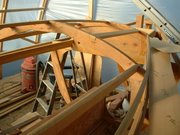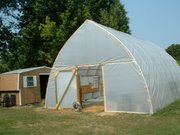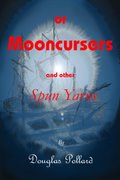Sailboats Fair and Fine: Read oldestest posts first
I decided I would take Woftrap and go sailing. For sailing in the Bahamas and farther south I felt that the cat yawl rig with it's 500 square foot main was unhandy for sailing the Bahamian winter northers. I wanted the rig broken up into smaller parts. That my aging self and wife could handle. See I thought I was getting old. Boy what a waste of good muscle and sinue that was.
We began building a new rig using what spars we could, from the cat yawl rig. Bob, David and I sat up late nights in my office and drew up a rig using Mr. Bolger's same center of effort. The main mast was shortened and stepped on deck just forward of the main hatch with shrouds. The forward mast partners were made smaller for a 4' dia. foremast that mast when stepped was shorter than the 35 ft main mast and was stayed.
To keep the center of effort in the same place we added two feet to the bow sprite and put side stays on it and a bob stay so the jib stay could be kept tight. The tops of the masts were stayed together. The mains stays were somewhat back so they would to some degree act as back stays. The length of the main boom was determined by how far I could reach standing on a cockpit seat and leaning out over the transom to adjust the out haul. We started off drawing a gaff main and gaff fore sail.
To get her to balance the bow sprite would have had to had to have been several feet longer. It was already 6ft long and would have gone to 9 feet. A bit much I thought. As a result we changed the main to a Bermuda rig, and a gaff foresail The top of the main mast was fitted for a sheet to the foresail gaff So that when trimming sails the yard could be trimmed in so that she had a good shape at the top and was pulling good. The the fore sail boom was sheeted in until it was pulling. There was a big advantage in this type of rig. The foresail controlled by two sheets could be pulling top and bottom and not back wind the main going to windward. With a rig like this she would and did sail to windward like a banshee. There was another halyard on the forward side of the main mast and that was for the flat spinnaker that had been used forward when Woftrap was a cat yawl. We used the flat spinnaker like a Genoa buy attaching the luff to the deck behind the foremast. On some occasions we used the old spinnaker pole to set the luff of the sail to windward when reaching and running.
We also had a spinnaker and Genoa that we only set a few times with a large crew on board. It was unbelievable and scary as hell!! I thought we were going to sail her right under and would have I believe if the wind had picked up. Still she was not as weatherly as she could have been.
She had a clubfooted jib that had to be hauled in tight to get the whole sail to pull. That caused the lower portion to back wind the foresail. Had there been a sprite it could have been sailed with the sail out just as far as the foresail and their would have been no back winding any of the sails. She would then sail to windward with most sloops even though her sails were a low aspect ratio. The difference being that all three sails would have 100% of all all there canvas pulling as compared to about 80% in the Bermuda rig. It absolutely amazes me that sloop sailors keep saying that the foresail on a ketch or a schooner back winds the aft sail so they are slower to windward. With that kind of thinking all boats would be faster if they were cat boats. I never see sloop sailors take their jib down when they sail to windward. The sail that is forward doesn't have to back wind the sail behind it unless you want it to.
Off the wind is where the schooner comes into its own, where it is faster than a sloop and when you add on a staysail or golly wobbler speeds pick up at least a knot no matter what speed you are sailing at.. The staysail is over the cockpit and is easily hoisted and lowered by one person. Now the speed is limited by how far you want to drive the bow down in the water and how much you you want to lift the stern out and will you be able to keep the rudder in the water. With a schooner rig there is a good reason to rake the mast. The longer the boom the more rake in the mast is needed. With the mast raked the boom lifts off the water as it swings out when running down wind.
After all this schooner bragging I have to admit that she was really a ketch I guess as the gaff foresail was slightly bigger than the main even though not as tall.
Woftrap was slower now with her new rig even though she had the same square footage in sail area as the cat yawl rig had. We could carry extra sails then she would outrun most anything around.
All this talk about speed leaves out the fact that with her new rig she was easy to handle. More so than with her original rig. All lines came back to the cockpit and there was a down haul on the jib. With her ease of steering and the ability to balance the helm every time new sail was added and the fact that all sails could be handled from the cockpit. I could single hand her with four sails pulling. The first reef amounted to dropping the staysail. Then she could be reefed by Dropping the foresail then reefing the jib and main. Then the foresail hoisted again and reefed. The whole time she would be sailing herself. The whole trick to reefing while single handing is watching the weather and reefing sooner than later. I can see no reason for being caught with too much sail up. When I was young and foolish I used to get caught once in a while but in recent years I have not allowed it to happen.
Two anchors hung under the bowsprit and they were threaded through blocks on the forward end of the sprite. Set from there there was no tenancy to sail in the wind when at anchor. It also kept anchor roads and chain off the forward sides of the boat. Woftrap's 8 hp engine would not pull the anchors into the bottom as tight as I liked them. We usually sailed or motored in, dropped a hook and sailed on dropping the second hook then sailing between then and when we thought we were halfway we would head to windward and wrap both roads tight around the Sampson post. She would pull them in halfway to hell for a secure nights sleep.






No comments:
Post a Comment